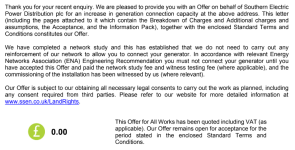Like a lot of people here, I had my worst solar day so far on Saturday with 2.47KWh, luckily had a good day Friday so started the day with 40% charge which helped a little, but still went flat early evening.
Spent most of the weekend messing around with the GivEnergy API using Javascript on my Athom Homey home automation controller. Got all the basic battery control working, plus data logging of the current state (generation, consumption, charge etc.) which I can then graph or export automatically, also grabbing historical data to calculate average usage for each half period on each individual day of the week and finally wrote a function that will charge the battery to a specific level by a given time (which I think is slightly smarter than the GivEnergy implementation).
The Homey has a nice system of logic where devices have "flow cards" associated with them (Events, Actions and Conditions), so I have created cards for the battery and can now integrate it easily with other devices, so can do logic like "If battery is 60% charged, and the outside temperature is 20, then turn on the kitchen light", or even something that has some sort of practical use! Currently just have it yelling at me when the battery either fully charges or fully discharges, but will hopefully come up with some more useful ways of using it, for instance, think I should be able to spot a power cut and automatically turn off devices to save battery charge etc.
Next step is to try and implement access to my Solcast solar forecast and use that along with the average usage data to automatically charge the battery to the optimum level overnight, which will be useful when my economy 7 tariff kicks in.
Finally, hoping to implement something that will optimise charging and export, based on Agile Outgoing prices, so for days with excess solar, working out the charge needed to fill the battery and doing that charging at the times with the lowest export prices and also and also controlling charge rate vs export to automatically account for the G98 export cap, so if generation exceeds the cap it will divert the excess to the battery.
Might all be largely pointless, but I'm enjoying myself!
Spent most of the weekend messing around with the GivEnergy API using Javascript on my Athom Homey home automation controller. Got all the basic battery control working, plus data logging of the current state (generation, consumption, charge etc.) which I can then graph or export automatically, also grabbing historical data to calculate average usage for each half period on each individual day of the week and finally wrote a function that will charge the battery to a specific level by a given time (which I think is slightly smarter than the GivEnergy implementation).
The Homey has a nice system of logic where devices have "flow cards" associated with them (Events, Actions and Conditions), so I have created cards for the battery and can now integrate it easily with other devices, so can do logic like "If battery is 60% charged, and the outside temperature is 20, then turn on the kitchen light", or even something that has some sort of practical use! Currently just have it yelling at me when the battery either fully charges or fully discharges, but will hopefully come up with some more useful ways of using it, for instance, think I should be able to spot a power cut and automatically turn off devices to save battery charge etc.
Next step is to try and implement access to my Solcast solar forecast and use that along with the average usage data to automatically charge the battery to the optimum level overnight, which will be useful when my economy 7 tariff kicks in.
Finally, hoping to implement something that will optimise charging and export, based on Agile Outgoing prices, so for days with excess solar, working out the charge needed to fill the battery and doing that charging at the times with the lowest export prices and also and also controlling charge rate vs export to automatically account for the G98 export cap, so if generation exceeds the cap it will divert the excess to the battery.
Might all be largely pointless, but I'm enjoying myself!






